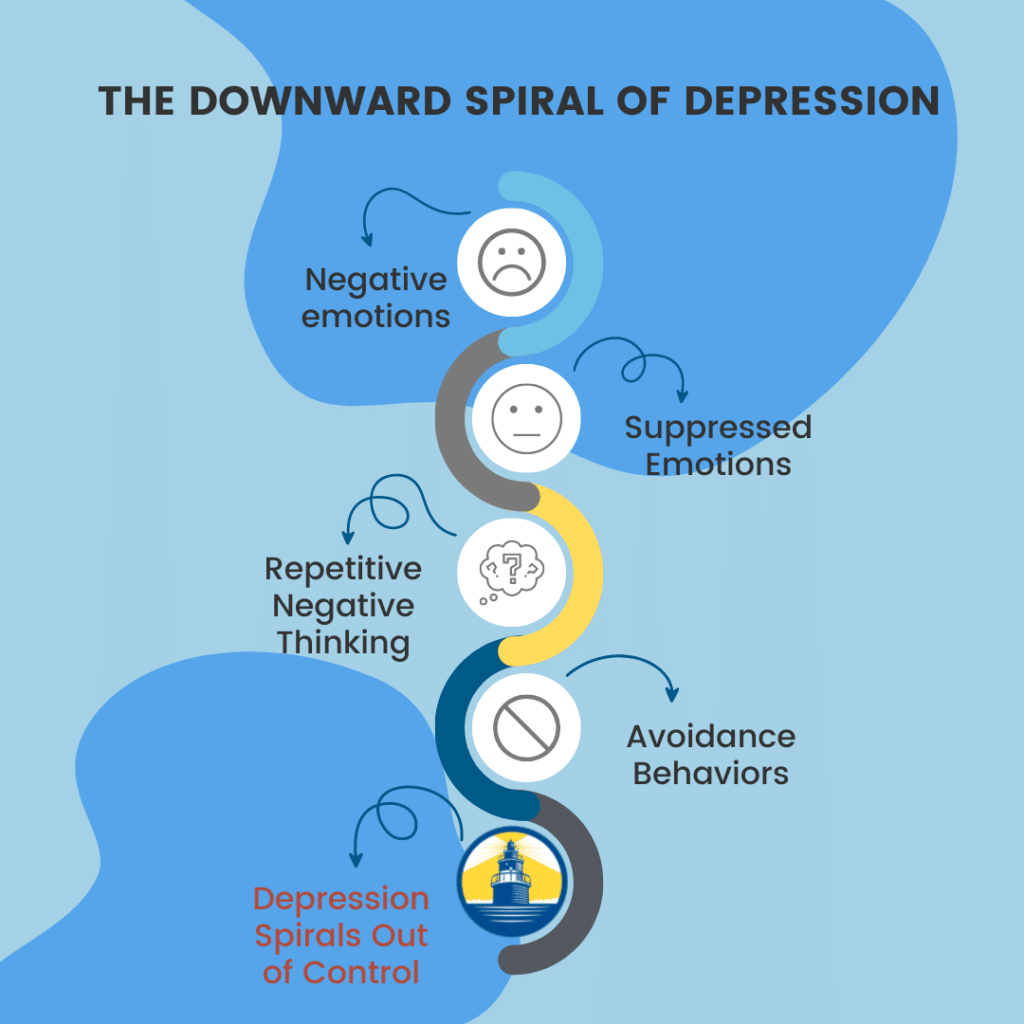The Downward Spiral:
What it is & How to Reverse it
Spiraling into a deep depressive episode is common in individuals with depression. Once an individual goes through one depressive episode, they become more likely to go through another one. Depression is a common mental health disorder that affects 4.8% of US adults as of 20194.
While in a spiral, individuals may not be aware of the downward trajectory of their depression. A downward spiral may vary in time duration, but while in the spiral it may become hard to recognize how far down the spiral you have gone.
The trajectory of the spiral may be easily recognized by friends and family, but the depressed spiral victim may not see the signs. A different perspective may be necessary to stop or reverse the downward spiral of depression.
Learning to recognize the signs of a downward spiral can be life-changing for mental health and well-being. With the proper tools and support the spiral can be reversed or moved in an upward direction rather than downward.
What is a Downward Spiral?
A downward spiral with depression is a situation defined by a series of negative thoughts, feelings, or actions that feed into themselves repeatedly causing the situation to become progressively worse. Learning to recognize a spiral before making it to the bottom can help avoid potential downward spirals in the future.
Stages of the depression spiral that can lead to depression spiraling out of control:
- Negative experience(s)
- Suppressing emotions
- Repetitive negative thinking
- Avoidance behaviors
Stopping and recognizing these stages can help stop or reverse the downward spiral of depression.

Depression
Sadness is a common emotion that everyone experiences from time to time. Chronic and clinical depression, however, can hinder the ability to participate in life. Depression is not a weakness, and in some cases, is a chemical disruption in the brain that requires therapy, medication, or both.
- Major Depressive Disorder (MDD) – clinical depression involving intense or overwhelming feelings that last longer than 2 weeks. Symptoms interfere with daily life.
- Bipolar Disorder – alternation between low mood (depressive) and high-energy (manic) periods. The low periods may include depression symptoms, such as hopelessness and lack of energy.
- Perinatal & Postpartum Depression – can occur during pregnancy and up to a year after the birth of the child. This is not the “baby blues”, this is ongoing stress, sadness, and worry that can be debilitating.
- Premenstrual Dysphoric Disorder (PMDD) – severe form of PMS that affects women in the days or weeks leading up to their menstrual cycle. Symptoms may be as extreme as suicidal ideation.
- Psychotic Depression – severe depressive symptoms which can include delusions or hallucinations. Delusions are beliefs in activities, people, or objects that are not based in reality. Hallucinations can occur when seeing, hearing, or touching things that are not physically present.
- Seasonal Affective Disorder (SAD) – depressive symptoms during seasonal changes. These symptoms can occur during the fall and winter or spring and summer.
What Causes a Spiral?
There is no one cause that contributes to the process of the downward spiral of depression. However, risk factors and a combination of causes can push an individual down the spiral of depression. Feelings of loss, suppressed emotions, and feelings of guilt or shame can contribute to a deepening of the spiral.
Feelings of Loss
Feelings of loss can occur when deprived of something important and do not have to be tangible. Loss of a friend, loss of a pet, loss of a job promotion are all losses that can be felt whether it is a living thing or an idea.
Different kinds of loss include:
- Situational Loss – unpredictable life events that lead to loss. Losing a job, being turned down for a promotion, divorce, moving out of the home you’ve been in for many years.
- Perceived Loss – internal loss based on the perceptions of the individual who is going through this process. These losses may not be tangible and may instead be the loss of an idea or belief.
- Actual Loss – losses of something of value that can no longer be touched, heard, or seen. Family members passing away, pets passing away, and losing a job, are all actual losses.
- Necessary Loss – good changes can initiate feelings of loss. A promotion may mean a different office and working away from my friends, but also the opportunity to learn and meet new people.
Suppressed Emotions
After experiencing a loss, negative emotions can start to appear. Naturally, negative emotions are not comfortable and are often repressed when an individual does not want to feel. Awareness of suppression of emotions can occur, but often individuals are unaware.
Avoiding feelings can be done by:
- Canceling social engagements
- Paying less attention to friends and loved ones
- Working overtime or taking work projects at home
- Exercising or going to the gym with increasing frequency
- Overeating, or drinking more alcohol than usual
- Spending too much time on social media, or in front of a screen
Emotional suppression is a common reaction to negative emotions, but can be detrimental to emotional wellbeing. Constantly pushing away negative emotions with unproductive and potentially unhealthy coping mechanisms can lead to more severe mental health problems in the future.
Guilt & Shame
Feelings of guilt and shame can negatively impact mental health by reducing self-confidence and self-esteem3. Constant feelings of guilt and shame can be a warning sign that depression is soon to arrive if it has not already manifested itself.
Guilt is the feeling associated when wrongdoing occurs. Conscious behaviors and actions that are not in line with perceived values can cause feelings of remorse and guilt.
Shame is the perceived value placed as a result of behaviors or actions. This perception is not based on logic and rationality but rather is based on an emotional response.
Shame and guilt are often used as a way of self-punishment. This type of self-punishment is a catalyst for speeding up the downward spiral of depression.
How to Recognize Spiraling
Breaking out of a depression downward spiral can be challenging, especially if there is no awareness of its happenings. Being on that spiral can be exhausting even if awareness of the spiral is lacking. The likelihood of a bout of depression increases after experiencing a depressive episode once.
Taking control of mental health and well-being involves awareness and assessment of mental health conditions and struggles at all times. A focus can be placed on promoting mental wellness by doing esteemable acts and self-care and avoiding activities that may harm mental health. Mental health is an ongoing, everlasting perspective of life that can take vigilance and awareness.
Depression Triggers
Triggers are events or situations that result in feelings of depression. Being able to recognize triggers for depression can be a difficult, but helpful process. Oftentimes, when feeling overwhelmed by emotions or supressing them can happen during a triggering event2.
Substance Abuse
Addictions to substances or alcohol can cause a downward spiral with depression. Substances are often used as a form of “self-medication” to treat depression symptoms. However, self-medication can lead to addictions and worsening depression symptoms.
Drugs and alcohol can offer quick bursts of stimulus or relaxation, but even occasional use can trigger a downhill spiral because these substances can only alter moods temporarily. Even with out the presence of a substance use disorder, the use of substances and alcohol occasionally can increase depression symptoms.
Stress
Stress can be seemingly unavoidable in these times, but it can be manageable. “Normal” stressors like school, work, or households stress can become overwhelming and is often a sign of a downward spiral of depression.
Physical Ailments or Injury
Medical conditions, whether severe or minor, can trigger depression episodes and symptoms. Lack of mobility or isolation due to medical illness can increase depression. Minor and/or temporary illness or injury can trigger depression.
Trauma, Grief, or Loss
Trauma, grief, and loss are commonly known to increase the risk of developing depression and triggering a depressive episode. Traumatic events can include car accidents, divorce, or the death of a loved one. Situations don’t have to be “dramatic” or traumatic to trigger feelings of depression.
Warning Signs of a Spiral
Being aware of the triggers that may spark a downward spiral of depression is a good first step, but it’s not always easy to do so right away. It can take time for feelings to take root and transform into a depression spiral that needs attention.
- Difficulty concentrating or focusing on tasks or situations
- Feeling indecisive about decisions that used to be easy or obvious
- Constantly feeling fatigue or getting easily exhausted
- Losing interest in people or activities that you once enjoyed
- Dreading a return to work after time off
- Feeling irritable
- Participating in negative self-talk
- Constant feelings of stress or anxiety
- Insomnia, sleeping too much, or changed sleeping patterns
- Neglecting self-care routines
These warning signs can be caused by a triggering event or there may not be a clear trigger that caused the downward spiral. Recognizing these warning signs is a great first step towards avoiding the downward spiral – and possibly even reversing it.
How to Break Out of a Spiral
After learning to recognize triggers and warning signs of a depression spiral, necessary action can be taken to avoid going deeper into the spiral. Healthy coping mechanisms can be used to help stop or reverse the depression cycle.
Self-Care
Self-care is crucial when it comes to mental health, especially depression6. Treatment for depression, including therapy appointments and medication, can be seen as a form of self-care.
Self-care can be little things, too, like reading a book or watching a funny movie. Journaling can also be used as a tool when suffering from depression. Writing about accomplishments throughout the week can contribute to positive self-esteem.
Engaging in a hobby or participating in a new activity can help revitalize interest in life. If finding a hobby or new activity is too challenging, simply taking a walk outside can help break the depression spiral.
Meditating and practicing mindfulness is a form of self-care that can help with the recognization of emotions and help stay in the present moment. When starting with these methods, begin with small goals and steps to reduce feelings that may arise from being overwhelmed.
Increase the "Happy" Brain Chemicals
Dopamine, serotonin, oxytocin, and endorphins are all naturally occurring chemicals in the body that help to facilitate feelings of happiness and peace5.
Exercise is an activity that increases all of these brain chemicals and can help improve mood. Finding the motivation to exercise while depressed can be difficult, but even less strenuous exercise can produce these brain chemicals. Exercising outside in the sunshine and fresh air can be restorative and increase the brain’s chemical serotonin.
Oxytocin production can occur when experiencing social interactions and physical touch. Holistic methods like meditation, acupuncture, and massage can also increase oxytocin. Meditation can also increase dopamine and endorphin levels.
Watch Self-Talk
Negative thoughts commonly appear during a depression spiral. Negative thoughts can be redirected by talking to a therapist, a friend, or a family member8. Getting feedback on negative thoughts after expressing them can provide relief and a different perspective.
Reach Out for Support
The U.S. culture is heavily focused on individualism and encourages strength and self-sufficiency. Although this is the culture in America, human beings thrive off of being involved in a community. Support and care from loved ones and friends can help with feelings of loneliness and hopelessness that are commonly associated with depression.
Making a list of friends, family, co-workers, or neighbors to call before the next spiral can be helpful in reversing and stopping the depression spiral by providing a sense of community. This list should consist of people that are trustworthy, provide a sense of safety, and are supportive.
Learning to recognize specific triggers and warning signs is a fantastic first step in avoiding that spiral altogether. Mixing this new knowledge with coping tools can help avoid or reduce the downward spiral of depression.
If you or a loved one are struggling with a depression downward spiral, reach out to Safe & Sound in Costa Mesa to seek help. Our compassionate team can answer any questions you may have and give you a better understanding of our program.
Sources
- Cleveland Clinic Medical Professional. (2020, December 31). Depression: Types, symptoms, causes & treatment. Cleveland Clinic. Retrieved February 19, 2022, from https://my.clevelandclinic.org/health/diseases/9290-depression
- Jabr, F. (2013, February 7). Researchers take a closer look at the most common and powerful triggers of depression. Scientific American. Retrieved February 21, 2022, from https://www.scientificamerican.com/article/triggers-of-depression/
- Kämmerer, A. (2019, August 9). The scientific underpinnings and impacts of shame. Scientific American. Retrieved February 21, 2022, from https://www.scientificamerican.com/article/the-scientific-underpinnings-and-impacts-of-shame/
- National Health Interview Survey. (2020, September). Early release of selected estimates from the 2019 national … Center for Disease Control and Prevention. Retrieved February 19, 2022, from https://www.cdc.gov/nchs/data/nhis/earlyrelease/EarlyRelease202009-508.pdf
- Raypole, C. (2019, September 30). Happy hormones: What they are and how to boost them. Healthline. Retrieved February 21, 2022, from https://www.healthline.com/health/happy-hormone
- Raypole, C. (2021, June 28). Self-care for depression: 10 tips to help you feel better. Psych Central. Retrieved February 21, 2022, from https://psychcentral.com/depression/self-care-for-depression#10.-Consider-dietary-changes
- Rodriguez, D. (2012, September 14). Spotting the signs of a depressive episode – major depression resource center – everyday health. EverydayHealth.com. Retrieved February 21, 2022, from https://www.everydayhealth.com/hs/major-depression/spot-signs-of-depressive-episode/
- Woolston, C. (2021, December 16). Overcoming negative thinking. HealthDay. Retrieved February 21, 2022, from https://consumer.healthday.com/encyclopedia/depression-12/depression-news-176/overcoming-negative-thinking-645055.html




